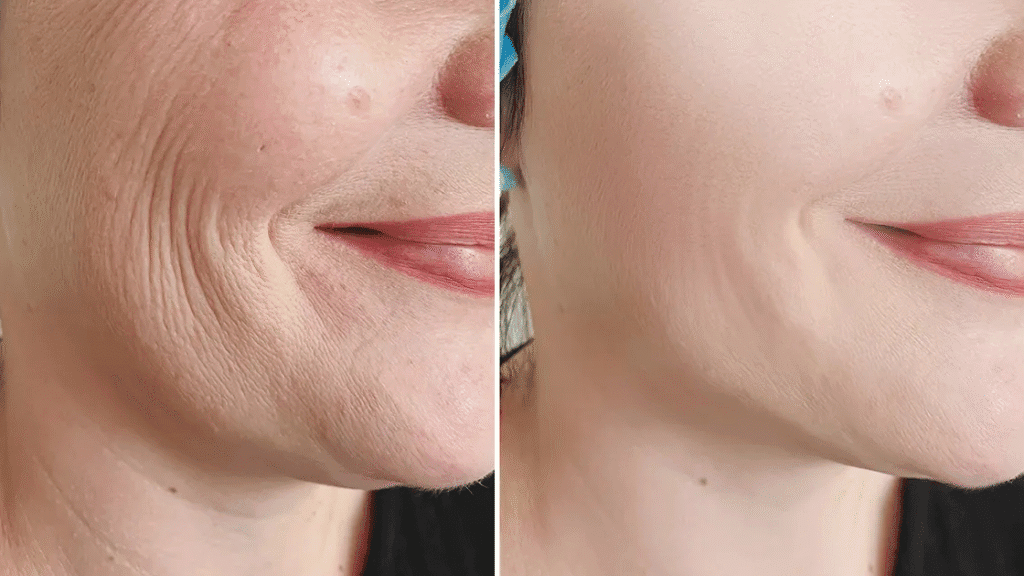1. Introduction: The Quest for Youthful Skin
In the ever-evolving landscape of aesthetic medicine, the pursuit of youthful, radiant skin has led to numerous innovative treatments. Among the most popular non-surgical options are radiofrequency (RF) skin tightening and dermal fillers, each offering unique approaches to combating the signs of aging. As patients increasingly seek alternatives to invasive procedures, a common question emerges: can RF treatments effectively replace dermal fillers? This comprehensive analysis explores the capabilities, limitations, and applications of both treatments, providing evidence-based insights to help you make informed decisions about your aesthetic journey. We’ll examine the science behind each approach, their clinical effectiveness, and when one might be preferred over the other.
2. Understanding the Basics: RF and Fillers
Before diving into comparisons, it’s essential to understand the fundamental mechanisms behind these two distinct aesthetic approaches. Each treatment targets different aspects of skin aging through unique biological pathways.
2.1 What Is Radiofrequency (RF) Skin Tightening?
Radiofrequency skin tightening represents a revolutionary non-invasive approach to skin rejuvenation that harnesses the power of controlled thermal energy. RF therapy uses low energy radiation to heat the deep layer of your skin, which stimulates the production of collagen, targeting the dermis and subcutaneous layers where structural changes occur with aging. The technology operates by delivering electromagnetic energy at specific frequencies, typically around 450 kilohertz, converts to thermal energy and creates small “injuries” to the lower levels of the skin. This controlled thermal damage triggers the body’s natural healing response, initiating neocollagenesis—the formation of new collagen fibers. The process also causes immediate collagen contraction, providing both instant and progressive results over several months.
2.2 What Are Dermal Fillers and How Do They Work?
Dermal fillers represent a different approach to facial rejuvenation, focusing on volume restoration rather than tissue restructuring. These injectable substances, primarily composed of hyaluronic acid (HA), work by physically adding volume to depleted areas of the face. Hyaluronic acid (HA) based dermal fillers; a non‐permanent injectable device, can restore volume loss, fill fine lines and wrinkles and add curves and contours. The mechanism involves strategically placing biocompatible substances beneath the skin’s surface to lift, plump, and smooth targeted areas. Modern fillers often incorporate cross-linking technology, which enhances longevity and provides structural support. The immediate volumizing effect addresses age-related volume loss, while some formulations can stimulate modest collagen production over time.
2.3 Comparing Treatment Goals: Volume vs. Tightness
Understanding the distinct therapeutic goals of each treatment is crucial for setting realistic expectations. RF treatments excel at addressing skin laxity, improving texture, and enhancing overall skin quality through collagen remodeling. The primary outcomes include skin tightening, pore refinement, and subtle lifting effects that develop gradually over 3-6 months. Conversely, dermal fillers provide immediate volume restoration and structural support, making them ideal for addressing deep folds, hollow areas, and specific contouring needs. While both treatments can improve facial aesthetics, they target fundamentally different aspects of the aging process, making direct replacement challenging in many cases.
3. Can RF Realistically Replace Fillers?
The question of whether RF can replace fillers requires a nuanced understanding of each treatment’s strengths and limitations. While both aim to rejuvenate facial appearance, their mechanisms and outcomes differ significantly, making complete replacement unlikely in all scenarios.
3.1 Face Areas Where RF Excels

Radiofrequency treatments demonstrate particular efficacy in areas where skin laxity is the primary concern. The technology shows exceptional results in treating the lower face and neck, where gravitational effects create sagging. Three months posttreatment, significant differences were noticed among subjects as they showed 70% to 75% improvements in skin tightening, particularly in the jowl area and jawline definition. The periorbital region responds well to RF treatments, with improvements in crow’s feet and under-eye skin texture. The forehead and temple areas also benefit from RF’s skin-tightening effects, creating a more youthful contour. Additionally, RF demonstrates effectiveness in treating body areas like the abdomen and arms, where fillers are not typically used.
3.2 Limitations of RF Compared to Fillers
Despite its effectiveness, RF technology has inherent limitations that prevent complete replacement of fillers in many scenarios. RF cannot add significant volume to areas with substantial fat pad atrophy, such as hollow cheeks or deep nasolabial folds. The treatment’s effects are primarily limited to skin tightening and modest lifting, rather than volumizing. Deep static wrinkles and pronounced facial hollowing require immediate volume replacement that only injectable fillers can provide. RF treatments also require multiple sessions and several months to achieve optimal results, unlike fillers which provide immediate correction. The technology cannot create dramatic contouring changes or address severe volume deficits that characterize advanced aging.
3.3 When to Choose RF Over Fillers
RF treatments are optimal choices for patients with mild to moderate skin laxity who prefer gradual, natural-looking improvements. Candidates with good facial volume but loose skin texture benefit most from RF technology. Those seeking non-injectable solutions or having contraindications to hyaluronic acid fillers represent ideal RF candidates. Patients in their 30s and early 40s experiencing early signs of skin laxity often achieve excellent results with RF alone. Additionally, individuals with active lifestyles who prefer treatments without immediate social downtime may find RF more suitable than fillers, which can cause temporary swelling and bruising.
3.4 Combination Treatments: RF and Fillers Together
The synergistic approach of combining RF and fillers often yields superior results compared to either treatment alone. For those seeking to minimise fine lines and wrinkles, combining dermal fillers with radio frequency microneedling is an effective way to achieve a rejuvenated, radiant complexion. This comprehensive strategy addresses both volume loss and skin quality simultaneously. RF treatment increased procollagen production in a time-dependent fashion, which can enhance and prolong filler results. The improved skin quality from RF treatments provides a better foundation for filler placement, potentially extending their longevity. Sequential treatments, where fillers address immediate volume needs and RF improves skin quality, create more natural and longer-lasting results.
3.5 Age-Related Suitability: Younger vs. Mature Skin
Age plays a crucial role in determining treatment suitability and expected outcomes. Younger patients (20s-30s) with minimal volume loss but early skin laxity may achieve excellent results with RF alone. Their robust collagen production capacity responds well to thermal stimulation, often providing dramatic improvements in skin quality and firmness. Mature patients (50s and beyond) typically require a combination approach, as advanced aging involves both significant volume loss and skin laxity. RF treatments can improve skin quality, but substantial volume deficits necessitate filler intervention. The aging process creates complex changes that benefit from multi-modal treatment approaches rather than single-therapy solutions.
4. Expert Opinions and Clinical Insights
Understanding the professional perspective on RF versus filler treatments provides valuable insights into clinical decision-making and patient outcomes. Expert opinions are based on extensive clinical experience and ongoing research in aesthetic medicine.
4.1 What Dermatologists and Aesthetic Doctors Say
Leading dermatologists emphasize that treatment selection should be individualized based on patient anatomy, aging patterns, and aesthetic goals. Many experts advocate for a comprehensive assessment approach, evaluating both volume loss and skin quality to determine optimal treatment strategies. The consensus suggests that RF and fillers serve complementary rather than competing roles in aesthetic medicine. Clinical experts frequently emphasize the importance of managing patient expectations, noting that RF provides gradual improvements over months, while fillers offer immediate results. Many practitioners report high patient satisfaction when treatments are appropriately matched to individual needs and concerns, highlighting the importance of proper candidate selection.
4.2 What Studies and Clinical Trials Reveal
Recent clinical research provides compelling evidence for RF effectiveness in skin rejuvenation. significant differences were noticed among subjects as they showed 70% to 75% improvements in skin tightening (P = .001), 65% to 70% improvement in skin texture (P = .002), 90% to 95% improvement in rhytides (P = .0001), and volunteer satisfaction increased to 90% three months post-treatment. evaluator-assessed FWCS scores showed significant improvement at 4 weeks (p < 0.005) and 8 weeks (p < 0.005) after treatment. All subjects reported different degrees of improvement in facial wrinkles after 8 weeks of treatment. These findings demonstrate RF’s clinical efficacy in addressing multiple aspects of facial aging, though volume restoration remains beyond its capabilities.
4.3 Patient Experience and Testimonials
Patient feedback consistently highlights RF’s gradual but noticeable improvements in skin texture and firmness. Many report increased confidence as skin quality improves over the treatment course. However, patients seeking immediate dramatic changes often express initial disappointment with RF’s subtle early results, emphasizing the importance of proper expectation setting. Long-term patient satisfaction with RF treatments is generally high, particularly among those who understand the gradual nature of collagen remodeling. Patients appreciate the natural-looking results and absence of foreign substances, though some miss the immediate gratification that fillers provide.

5. Considerations Before Choosing RF
Making an informed decision about RF treatments requires careful consideration of multiple factors, including financial investment, lifestyle impact, and individual suitability. These considerations help ensure optimal outcomes and patient satisfaction.
5.1 Cost Comparison: Fillers vs. RF Sessions
The financial comparison between RF and fillers involves both immediate costs and long-term investment considerations. RF treatments typically require a series of sessions, with most protocols recommending 3-6 treatments for optimal results. Individual session costs vary by geographic location and provider expertise, generally ranging from moderate to high investment levels. Fillers involve higher upfront costs per treatment but may require fewer sessions initially. However, maintenance treatments are necessary every 6-18 months depending on product type and individual metabolism. Long-term cost analysis often favors RF treatments, as results can last 1-2 years with proper maintenance, potentially reducing overall treatment frequency and expense.
5.2 Downtime and Side Effects
RF treatments offer significant advantages in terms of downtime and recovery compared to many aesthetic procedures. Most patients experience mild redness and slight swelling immediately post-treatment, typically resolving within 24-48 hours. The non-invasive nature allows most individuals to return to normal activities immediately after treatment sessions. Common side effects include temporary skin sensitivity, mild swelling, and occasional bruising at treatment sites. Serious complications are rare when treatments are performed by qualified practitioners using appropriate parameters. Some patients report temporary skin dryness or flaking as collagen remodeling occurs, typically resolving within one week.
5.3 Who Should Avoid RF Treatments?
Certain medical conditions and circumstances contraindicate RF treatments, requiring careful screening before proceeding. Patients with active skin infections, open wounds, or inflammatory conditions in treatment areas should postpone RF therapy until complete healing occurs. Pregnancy and breastfeeding represent absolute contraindications due to unknown effects on fetal development. Individuals with pacemakers, metal implants, or electronic medical devices may be unsuitable candidates depending on device type and location. History of skin cancer in treatment areas requires oncological clearance before proceeding. Patients with unrealistic expectations or those seeking immediate dramatic changes may be better suited for alternative treatments.
6. Conclusion: Fillers and RF—Friends, Not Foes
The relationship between Радиочастотные процедуры and dermal fillers is best characterized as complementary rather than competitive. Each technology addresses different aspects of facial aging through distinct mechanisms, making complete replacement unlikely in most scenarios. RF excels at improving skin quality, texture, and mild laxity, while fillers provide immediate volume restoration and structural support. The future of aesthetic medicine lies in personalized treatment approaches that combine multiple modalities for optimal outcomes. Rather than viewing RF and fillers as alternatives, considering their synergistic potential often yields superior results. Tighter, firmer, and more youthful-looking skin with improved texture and tone. Radio frequency microneedling is highly effective for reducing fine lines, wrinkles, acne scars, and overall skin laxity, while fillers address volume and contour needs. Successful aesthetic outcomes depend on proper patient selection, realistic expectation setting, and individualized treatment planning. Consultation with qualified practitioners who understand both technologies’ capabilities and limitations ensures optimal treatment selection and patient satisfaction.
7. Вопросы и ответы
Not entirely. RF (radiofrequency) tightens skin by stimulating collagen, while fillers restore lost volume. RF can enhance firmness, but it won’t replace the plumping effects of fillers in areas like cheeks or lips.
RF works best on areas with skin laxity but minimal volume loss, such as the jawline, neck, nasolabial folds, and under-eye region. It’s excellent for contouring and smoothing.
Yes, many experts recommend combining the two. RF improves skin tone and tightness, while fillers restore youthful volume—together, they deliver more natural and balanced results.
RF is generally considered safer and non-invasive with fewer side effects. However, both are safe when performed by certified professionals. Risks increase significantly when done by unqualified providers.
RF results typically last 6–12 months depending on age and skin condition, while dermal fillers can last 9–18 months. Maintenance sessions may be needed for both.
Absolutely. RF is needle-free and non-surgical, making it ideal for patients seeking rejuvenation without injections. It’s a popular choice for first-timers and those with filler anxiety.
8. Ссылки
- Радиочастотное воздействие на лоб против морщин
- Радиочастотный прибор
- The Efficacy, Longevity, and Safety of Combined Radiofrequency Treatment and Hyaluronic Acid Filler for Skin Rejuvenation
- Радиочастотное омоложение лица: Доказательный эффект
- Эффективность радиочастотного аппарата для омоложения возрастной кожи в домашних условиях: Рандомизированное клиническое испытание с раздельными лицами







